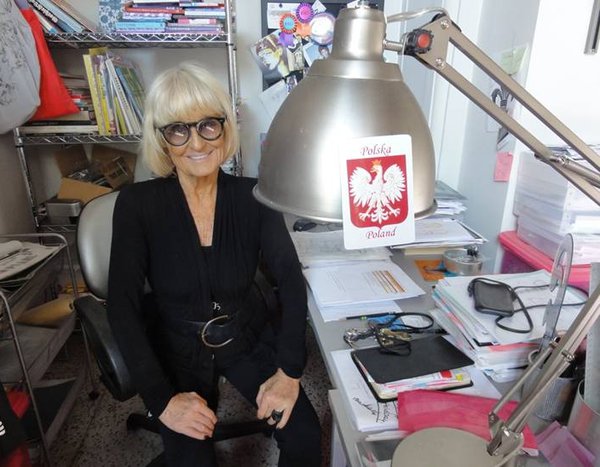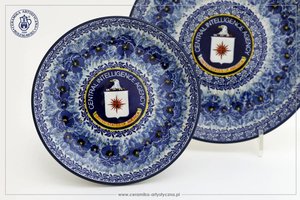Polish designers set global trends
American politicians wear their jewellery while critics put their designs on the covers of coffee-table books about art. Polish jewellery designers, Jacek Ostrowski and Kacper Dolatowski, are conquering the world of fashion, as other Polish fashion designers and style icons, Barbara Hulanicki, Jadwiga Grabowska and Misia Sert, did before.
Dragon is dynamic and very elegant. Its silver scales make it look like it is about to fly off. In his mouth he holds a round piece of amber polished in a way that is typical for a diamond. The ring designed by Jacek Ostrowski became famous when it appeared on the cover of Natalio Martin’s Jewellery Design in 2013, allowing the Polish designer in the group of 68 most important artists in the world.
Jacek Ostrowski, a graduate of the Industrial Design Institute at the Koszalin University of Technology, decided to devote himself to jewellery design in 2006, when he won the Mercurius Gedanensis competition at the “Amberif” International Fair of Amber, Jewellery and Gemstones in Gdansk. Ostrowski-Design, his company established in 1999, offers rings, necklaces and bracelets inspired by the surrounding world and, as Ostrowski puts it, “dominated by geometry, symmetry and rhythm.” Fascinated by simple forms, the Polish designer mainly uses silver, colourful acrylic, Swarovski Elements crystals and Baltic amber. Rings from the Big Ring collection, a combination of acrylic and Swarovski crystals, were put on a cover of German Vogue.
According to the United Nations’ Creative Economy report of 2010, Poland ranks eighth among developed countries in terms of design exports (before the Netherlands and Japan). The biggest jewellery companies in the world appreciate Polish talents. For eight years, Kacper Dolatowski worked for the prestigious Tiffany & Co. in Manhattan. Former U.S. Secretary of State Condoleezza Rice would wear cufflinks designed by this 38 year-old designer from Wroclaw. During his work for Tiffany’s, Dolatowski also created tableware for 60 people for the king of Qatar and the glass container in which U.S. First Lady Michelle Obama presents White House Honey to her guests.
Kacper Dolatowski owes his first dream job to his designs of rings from the times when he attended a school of fine arts in Wroclaw. The artist later developed his skills at the Academy of Fine Arts and the Rochester Institute of Technology, but Tiffany’s mainly focused on his creative approach to design. In fact, the company looked for someone with a thorough knowledge of history of art rather than an artist with a wealth of experience.
After quitting Tiffany’s, Dolatowski established his own company, Axon Design, which specialises in lighting. Its chandeliers embellish a boutique of Marc Jacobs, his regular customer.
 However, Jacek Ostrowski and Kacper Dolatowski are not the first Poles to have entered the great world of fashion. Barbara Hulanicki is a true style icon. She went down in history as the one who brought fashion to the British people. In the 1960s, she opened the first boutique in London where clothes were not handed to clients at the counter, but could be touched and tried on. Such stars as the Beatles, the Rolling Stones, Yoko Ono, David Bowie and Marianne Faithfull used to visit the cult “Biba” boutique. Anna Wintour, the famous editor-in-chief of American Vogue, worked there as a teenager.
However, Jacek Ostrowski and Kacper Dolatowski are not the first Poles to have entered the great world of fashion. Barbara Hulanicki is a true style icon. She went down in history as the one who brought fashion to the British people. In the 1960s, she opened the first boutique in London where clothes were not handed to clients at the counter, but could be touched and tried on. Such stars as the Beatles, the Rolling Stones, Yoko Ono, David Bowie and Marianne Faithfull used to visit the cult “Biba” boutique. Anna Wintour, the famous editor-in-chief of American Vogue, worked there as a teenager.
Hulanicki left Poland at three, before the outbreak of World War Two. First, she lived in Jerusalem, and then she moved to London. As a teenager, she wanted to change her surname to “Brown” or “Smith,” but eventually she realised that the Polish surname, often mispronounced by the British people, makes her more recognisable.
A graduate of the Brighton School of Arts, she dreamed of changing the grey and poor fashion of the post-war London into something more colourful. Fascinated by Art Nouveau and Art Deco, she imagined long, colourful, airy dresses, wide brim hats and low necklines. She wanted to offer the British women something different from tailored jackets suitable for 5 o’clock, so she began to sell her fancy designs by mail delivery. The prices were so low that very soon she received over 70,000 orders. She opened a boutique called “Biba,” a diminutive of her name Barbara, in a Victorian tenement at Abingdon Road, Kensington. The Art Deco-inspired boutique located on five floors sold the cult clothes for 2 pounds each. Only in London, Hulanicki had as many as five boutiques in the 1970s. The clothes signed “Biba” were an object of desire for the then fashion victims. Hulanicki is also said to have popularised miniskirts.
In 1976, the Poland-born fashion designer closed her boutique and sold 75% of her shares to Dorothy Perkins and Dennick Day. Another door opened for Hulanicki as she switched to interior design, a job that she still performs today, mainly working at her home in Miami, Florida. Before the Hulanicki era dawned in London, Warsaw went crazy about designs by Jadwiga Grabowska, who opened the first fashion boutique in Poland after World War Two, and then took the helm at Moda Polska, a public company established to promote and popularise global fashion trends in communist Poland.
The style of Jadwiga Grabowska had nothing to do with the roughness of social realism. It was fresh, bold and expensive. “Paris has Chanel, Warsaw has ‘Grabolka,’” people used to say.
Born into a wealthy family, this Jewish polyglot educated in Warsaw and Paris, wore Chanel already before the war. When Poland became free again, she impressed everyone wearing well-fitted skirts and jackets, and her signature turban. Thanks to her connections in Paris, Poland was the only country behind the Iron Curtain to have a representative at fashion fairs and shows.
Thanks to Jadwiga Grabowska, Moda Polska got the best materials produced in Polish factories (for example in Lodz) as well as the possibility to buy fabrics abroad. Grabowska also created the first school of models in post-war Poland. She spotted her models on the street, as today’s head hunters do.
Jadwiga Grabowska’s fame was said to have reached Paris. But one Misia Sert, the daughter of Cyprian Godebski, a Polish sculptor, had been a symbol of French elegance long before “Grabolka” started to show up in Parisian fashion houses. In 1895, a painting of her wearing fur and a large hat was put on the cover of La Revue Blanche. Designed by Henri de Toulouse-Lautrec, a famous painter, the cover became a symbol of Paris of the turn of centuries. Pierre-Auguste Renoir and Pablo Picasso also portrayed Misia Sert. The Polish style icon and patron of artists was a witness at Picasso’s wedding with Olga Koklova, and the godmother of the couple’s son. Called “the queen of Paris,” she was friends with many of the great figures of her time and a source of inspiration for Coco Chanel. At the turn of 2013, Musée d’Orsay organised a special exhibition dedicated to her.
KAROLINA KOWALSKA
04.11.2014







